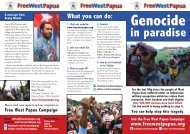Risky Business: The Grasberg Gold Mine An ... - Free West Papua
Risky Business: The Grasberg Gold Mine An ... - Free West Papua
Risky Business: The Grasberg Gold Mine An ... - Free West Papua
Create successful ePaper yourself
Turn your PDF publications into a flip-book with our unique Google optimized e-Paper software.
THE LESS WELL-KNOWN IMPACTS<br />
SOIL<br />
Due to international concern about contaminants in the tailings,PT<br />
<strong>Free</strong>port finally agreed to implement an environmental<br />
monitoring program at <strong>Grasberg</strong>.However, PT <strong>Free</strong>port’s sample<br />
data is not available to the public, and the company refuses<br />
to permit independent institutions to undertake monitoring<br />
activities within the mining area. Consequently, credible information<br />
about the environmental impact of the mine is scarce.<br />
Based on samples collected at Timika in mid-1995 by an<br />
American citizen 70 , Project Underground has developed a<br />
revealing analysis of the pollution problems from the mine 71 .<br />
Samples were taken approximately 100 km south of <strong>Grasberg</strong><br />
Fig.1<br />
Copper Zinc Lead<br />
Ajkwa River Sediment (n=3) 2290 53.3 1.35<br />
World Shale Standard 72 45 95 20<br />
NHMRC* 60 200 300<br />
All concentrations in parts per million (ppm)<br />
* National Health and Medical Research Council Guidelines for the Assessment of Contaminated sites 73<br />
Independent <strong>An</strong>nual Report on P.T. <strong>Free</strong>port Indonesia<br />
along the Ajkwa river (NB impacts are likely to be much worse<br />
closer to the mine).Despite recent increases in mine output it<br />
is unlikely that the concentration of metals found at this location<br />
have changed significantly in the intervening period. While<br />
the sediments on the Ajkwa river contain relatively low levels<br />
of zinc and lead,they contain extremely significant quantities of<br />
copper.This finding is no surprise since CEO Moffett,at the<br />
1997 annual meeting of <strong>Free</strong>port McMoRan Copper & <strong>Gold</strong>,<br />
admitted the company loses 200 tonnes of copper a day in its<br />
tailings dumping.Not only is this bad business—literally throwing<br />
away the product the company is there to produce—it is<br />
clearly dangerous.<br />
Copper concentrations in these sediments were found to be<br />
38 times the level at which the Australia and New Zealand<br />
National Health and Medical Research Council (NHMRC) recommends<br />
a site be declared “contaminated” and subject to an<br />
investigation to assess the health risk posed to neighboring<br />
communities.<strong>The</strong>se are comparable to World Health<br />
Organization and US EPA standards.<br />
WATER<br />
<strong>The</strong> sediment load of rivers downstream of <strong>Grasberg</strong> makes them nonpotable, according to local government officials.<br />
Tailings disposal has also had a dramatic and detrimental effect<br />
on water quality in the Ajkwa River System. This is evident<br />
from a photographic view of the river. In June 1992,<strong>Free</strong>port’s<br />
Environmental Manager told local people to stop eating sago<br />
15



